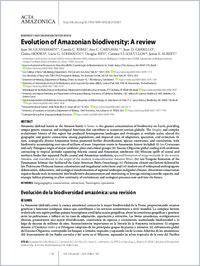Evolution of Amazonian biodiversity: A review
DOKPE
- GUAYASAMIN, Juan M. ORCID Universidad San Francisco de Quito (USFQ), Ecuador
- RIBAS, Camila C. ORCID Instituto Nacional de Pesquisas da Amazônia (INPA), Brazil
- CARNAVAL, Ana C. ORCID City University of New York, USA
- CARRILLO, Juan D. ORCID Université de Fribourg
- HOORN, Carina ORCID University of Amsterdam, Netherlands
- LOHMANN, Lúcia G. ORCID University of California, USA
- RIFF, Douglas ORCID Universidade Federal de Uberlândia, Brazil
- ULLOA ULLOA, Carmen ORCID Missouri Botanical Garden, USA
- ALBERT, James S. ORCID University of Louisiana at Lafayette, USA
- 2024
Published in:
- Acta Amazonica. - São Paulo, Brasil: FapUNIFESP (SciELO). - 2024, vol. 54, no. Spe. 1, p. 1-34
English
Amazonia (defined herein as the Amazon basin) is home to the greatest concentration of biodiversity on Earth, providing unique genetic resources and ecological functions that contribute to ecosystem services globally. The lengthy and complex evolutionary history of this region has produced heterogeneous landscapes and riverscapes at multiple scales, altered the geographic and genetic connections among populations, and impacted rates of adaptation, speciation, and extinction. In turn, ecologically diverse Amazonian biotas promoted further diversification, species coexistence, and coevolution, with biodiversity accumulating over tens of millions of years. Important events in Amazonian history included: (i) late Cretaceous and early Paleogene origin of major rainforest plant and animal groups; (ii) Eocene-Oligocene global cooling with rainforests contracting to tropical latitudes separating Atlantic coastal and Amazonian rainforests; (iii) Miocene uplift of central and northern Andes that separated Pacific coastal and Amazonian rainforests, spurred formation of mega-wetlands in the western Amazon, and contributed to the origin of the modern transcontinental Amazon River; (iv) late Neogene formation of the Panamanian Isthmus that facilitated the Great American Biotic Interchange; (v) Pleistocene climate oscillations followed by late Pleistocene-Holocene human colonization and megafaunal extinctions; and (vi) modern era of widespread anthropogenic deforestation, defaunation, and ecological transformations of regional landscapes and global climates. Amazonian conservation requires decade-scale investments into biodiversity documentation and monitoring to leverage existing scientific capacity, and strategic habitat planning to allow continuity of evolutionary and ecological processes now and into the future.
- Faculty
- Faculté des sciences et de médecine
- Department
- Département de Biologie
- Language
-
- English
- Classification
- Biology, life sciences
- License
- Open access status
- gold
- Identifiers
-
- DOI 10.1590/1809-4392202103601
- ISSN 1809-4392
- ISSN 0044-5967
- Persistent URL
- https://folia.unifr.ch/unifr/documents/329977
Statistics
Document views: 107
File downloads:
- guayasaminetal.-2024-evolutionofamazonianbiodiversityareview_0: 116
